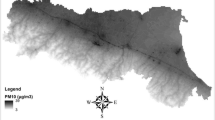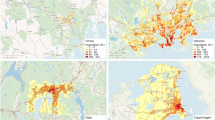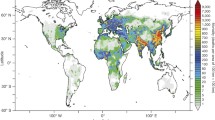Abstract
Domestic wood combustion and traffic are the two most significant primary fine particulate matter (PM2.5) emission source categories in Finland. We estimated emission–exposure relationships for primary PM2.5 emissions from these source categories using intake fractions (iF), which describes the fraction of an emission that is ultimately inhaled by a target population. The iFs were calculated for four different emission source subcategories in Finland in 2000: (1) domestic wood combustion in residential buildings, (2) domestic wood combustion in recreational buildings, (3) traffic exhaust and wear emissions, and (4) traffic resuspension emissions. The iFs were estimated for both total population and for subpopulations with different gender, age, and educational status. Primary PM2.5 emissions were based on the Finnish Regional Emission Scenario model and the dispersion of particles was calculated using the Urban Dispersion Modeling system of Finnish Meteorological Institute. Both emissions and dispersion were estimated on a 1 km spatial resolution. The iFs for primary PM2.5 emissions from (1) residential and (2) recreational buildings were 3.4 and 0.6 per million, respectively. The corresponding iF for (3) traffic exhaust and wear and (4) traffic resuspension emissions were 9.7 and 9.5 per million, respectively. The differences in population-weighted outdoor concentrations were significant between subpopulations with different educational status so that people with higher education were exposed more to traffic-related PM2.5.




Similar content being viewed by others
References
Beelen R, Hoek G, van den Brandt P, Goldbohm R, Fischer P, Schouten L, Armstrong B, Brunekreef B (2008) Long-term exposure to traffic-related air pollution and lung cancer risk. Epidemiology 19:702–710
Bennett D, McKone T, Evans J, Nazaroff W, Margni M, Jolliet O, Smith K (2002) Defining intake fraction. Environ Sci Technol 36(9):206A–211A
Brunekreef B, Holgate S (2002) Air pollution and health. Lancet 360:1233–1242
de Leeuw F, Horàlek J (2009) Assessment of the health impacts of exposure to PM2.5 at a European level. ETC/ACC Technical paper 2009/1 June 2009. Netherlands. Available at: http://air-climate.eionet.europa.eu/docs/ETCACC_TP_2009_1_European_PM2.5_HIA.pdf
Dockery D, Pope C, Xu X, Spengler J, Ware J, Fay M, Ferris B, Speizer F (1993) An association between air pollution and mortality in six U.S. cities. N Engl J Med 329:1753–1759
Evans J, Wolff S, Phonboon K, Levy J, Smith K (2002) Exposure efficiency: an idea whose time has come? Chemosphere 49:1075–1091
Greco S, Wilson A, Spengler J, Levy J (2007) Spatial patterns of mobile source particulate matter emissions-to-exposure relationships across the United States. Atmos Environ 41(5):1011–1025
Greene N, Morris V (2006) Assessment of public health risks associated with atmospheric exposure to PM2.5 in Washington, DC, USA. Int J Environ Res Public Health 3(1):86–97
Hänninen OO, Lebret E, Ilacqua V, Katsouyanni K, Künzli N, Srám RJ, JAntunen M (2004) Infiltration of ambient PM2.5 and levels of indoor generated non-ETS PM2.5 in residences of four European cities. Atmos Environ 38:6411–6423
Hystad P, Setton E, Allen R, Keller P, Brauer M (2009) Modeling residential fine particulate matter filtration for exposure assessment. J Exp Sci Environ Epid 19:570–579
Kan H, London S, Chen G, Zhang Y, Song G, Zhao N, Jiang L, Chen B (2008) Season, sex, age, and education as modifiers of the effects of outdoor air pollution on daily mortality in Shanghai, China: the Public Health and Air Pollution in Asia (PAPA) Study. Environ Health Perspect 116(9):1183–1188
Karppinen A, Joffre SM, Vaajama P (1997) Boundary layer parameterization for Finnish regulatory dispersion models. Int J Environ Pollut 8:557–564
Karppinen A, Kukkonen J, Nordlund G, Rantakrans E, Valkama I (1998) A dispersion modelling system for urban air pollution. Finnish Meteorological Institute, Publications on Air Quality 28, Helsinki. p 58
Karppinen A, Kukkonen J, Elolähde T, Konttinen M, Koskentalo T, Rantakrans E (2000a) A modelling system for predicting urban air pollution, model description and applications in the Helsinki metropolitan area. Atmos Environ 34–22:3723–3733
Karppinen A, Kukkonen J, Elolähde T, Konttinen M, Koskentalo T (2000b) A modelling system for predicting urban air pollution, comparison of model predictions with the data of an urban measurement network. Atmos Environ 34–22:3735–3743
Karvosenoja N, Tainio M, Kupiainen K, Tuomisto JT, Kukkonen J, Johansson M (2008) Evaluation of the emissions and uncertainties of PM2.5 originated from vehicular traffic and domestic wood combustion in Finland. Boreal Environ Res 13:465–474
Karvosenoja N, Kangas L, Kupiainen K, Kukkonen J, Karppinen A, Sofiev M, Tainio M, Paunu V-V, Ahtoniemi P, Tuomisto JT, Porvari P (2010) Integrated modeling assessments of the population exposure in Finland to primary PM2.5 from traffic and domestic wood combustion on the resolutions of 1 and 10 km. Air Qual Atmos Health. doi:10.1007/s11869-010-0100-9
Kauhaniemi M, Karppinen A, Härkönen J, Kousa A, Alaviippola B, Koskentalo T, Aarnio P, Elolähde T, Kukkonen J (2008) Evaluation of a modelling system for predicting the concentrations of PM2.5 in an urban area. Atmos Environ 42(19):4517–4529
Kukkonen J, Sokhi R, Luhana L, Härkönen J, Salmi T, Sofiev M, Karppinen A (2008) Evaluation and application of a statistical model for assessment of long-range transported proportion of PM2.5 in the United Kingdom and in Finland. Atmos Environ 42:3980–3991
Kupiainen K (2007) Road dust from pavement wear and traction sanding. Monographs of the Boreal Environmental Research 26. p 50
Kupiainen K, Karvosenoja N, Porvari P (2007) Non-exhaust particle emissions from traffic sources in Finland. In: Doley D (ed) Proceedings of the 14th World Congress of IUAPPA, Brisbane, Australia, 9–14 Sept 2007. CD-ROM. p 6
Levy J, Wolff S, Evans J (2002a) A regression-based approach for estimating primary and secondary particulate matter intake fractions. Risk Anal 22(5):895–904
Levy J, Greco S, Spengler J (2002b) The importance of population susceptibility for air pollution risk assessment: a case study of power plants near Washington, DC. Environ Health Perspect 110:1253–1260
Marshall J, Teoh S, Nazaroff W (2005) Intake fraction of nonreactive vehicle emissions in US urban areas. Atmos Environ 39:1363–1371
Molnar P, Gustafson P, Johannesson S, Boman J, Barregard L, Sallsten G (2005) Domestic wood burning and PM2.5 trace elements: personal exposures, indoor and outdoor levels. Atmos Environ 39(14):2643–2653
Pope C, Burnett R, Thun M, Calle E, Krewski D, Ito K, Thurston G (2002) Lung cancer, cardiopulmonary mortality, and long-term exposure to fine particulate air pollution. JAMA—J Am Med Assoc 280:1132–1141
Ries F, Marshall J, Brauer M (2009) Intake fraction of Urban wood smoke. Environ Sci Technol 43:4701–4706
Rotko T, Koistinen K, Hänninen O, Jantunen M (2000) Sociodemographic descriptors of personal exposure to fine particles (PM2.5) in EXPOLIS Helsinki. J Expo Anal Env Epid 10(4):385–393
Sofiev M, Siljamo P, Valkama I, Ilvonen M, Kukkonen J (2006) A dispersion modelling system SILAM and its evaluation against ETEX data. Atmos Environ 40:674–685
Stevens G, de Foy B, West J, Levy J (2007) Developing intake fraction estimates with limited data: comparison of methods in Mexico City. Atmos Environ 41(17):3672–3683
Tainio M, Sofiev M, Hujo M, Tuomisto JT, Loh M, Jantunen MJ, Karppinen A, Kangas L, Karvosenoja N, Kupiainen N, Porvari P, Kukkonen J (2009a) Evaluation of the European population intake fraction for European and Finnish anthropogenic primary fine particulate matter emissions. Atmos Environ 43:3052–3059
Tainio M, Karvosenoja N, Porvari P, Raateland A, Tuomisto JT, Johansson M, Kukkonen J, Kupiainen K (2009b) A simple concept for GIS-based estimation of population exposure to primary fine particles from vehicular traffic and domestic wood combustion. Bor Env Res 14:850–860
Tainio M, Tuomisto JT, Pekkanen J, Karvosenoja N, Kupiainen K, Porvari P, Sofiev M, Karppinen A, Kangas L, Kukkonen J (2010) Uncertainty in health risks due to anthropogenic primary fine particulate matter from different source types in Finland. Atmos Environ 44:2125–2132
Watkiss P, Pye S, Holland M (2005) Baseline Scenarios for Service Contract for carrying out cost-benefit analysis of air quality related issues, in particular in the clean air for Europe (CAFE) programme. AEAT/ED51014/Baseline Issue 5. Available at: http://www.cafe-cba.org/assets/baseline_analysis_2000-2020_05-05.pdf
WHO (2003) Health aspects of air pollution with particulate matter, ozone and nitrogen dioxide. 2003. Report on a WHO working group Bonn, Germany, 13–15 January 2003
Zhou Y, Levy JI (2007) Factors influencing the spatial extent of mobile source air pollution impacts: a meta-analysis. BMC Public Health 7:89
Acknowledgments
This study was performed as a part of the projects PILTTI (funded by the Ministry of the Environment, Finland, grant no. YM57/065/2005), INTARESE (funded by European Union, grant no. 018385–2), BIOHER (funded by Finnish Academy, grant no. 10155), MEGAPOLI (funded by European Union, FP/2007-2011, grant no. 212520), and Climate change, air quality and housing—future challenges to public health CLAIH (funded by Finnish Academy, grant no. 129355). This work was a part of the work in the Centre for Environmental Health Risk Analysis (jointly funded by the Academy of Finland, grants no. 53307, 111775, and 108571, and the National Technology Agency of Finland (Tekes) grant no. 40715/01).
We would like to thank Mr. Kari Pasanen for his valuable help with ArcGis calculations.
Author information
Authors and Affiliations
Corresponding author
Rights and permissions
About this article
Cite this article
Taimisto, P., Tainio, M., Karvosenoja, N. et al. Evaluation of intake fractions for different subpopulations due to primary fine particulate matter (PM2.5) emitted from domestic wood combustion and traffic in Finland. Air Qual Atmos Health 4, 199–209 (2011). https://doi.org/10.1007/s11869-011-0138-3
Received:
Accepted:
Published:
Issue Date:
DOI: https://doi.org/10.1007/s11869-011-0138-3




